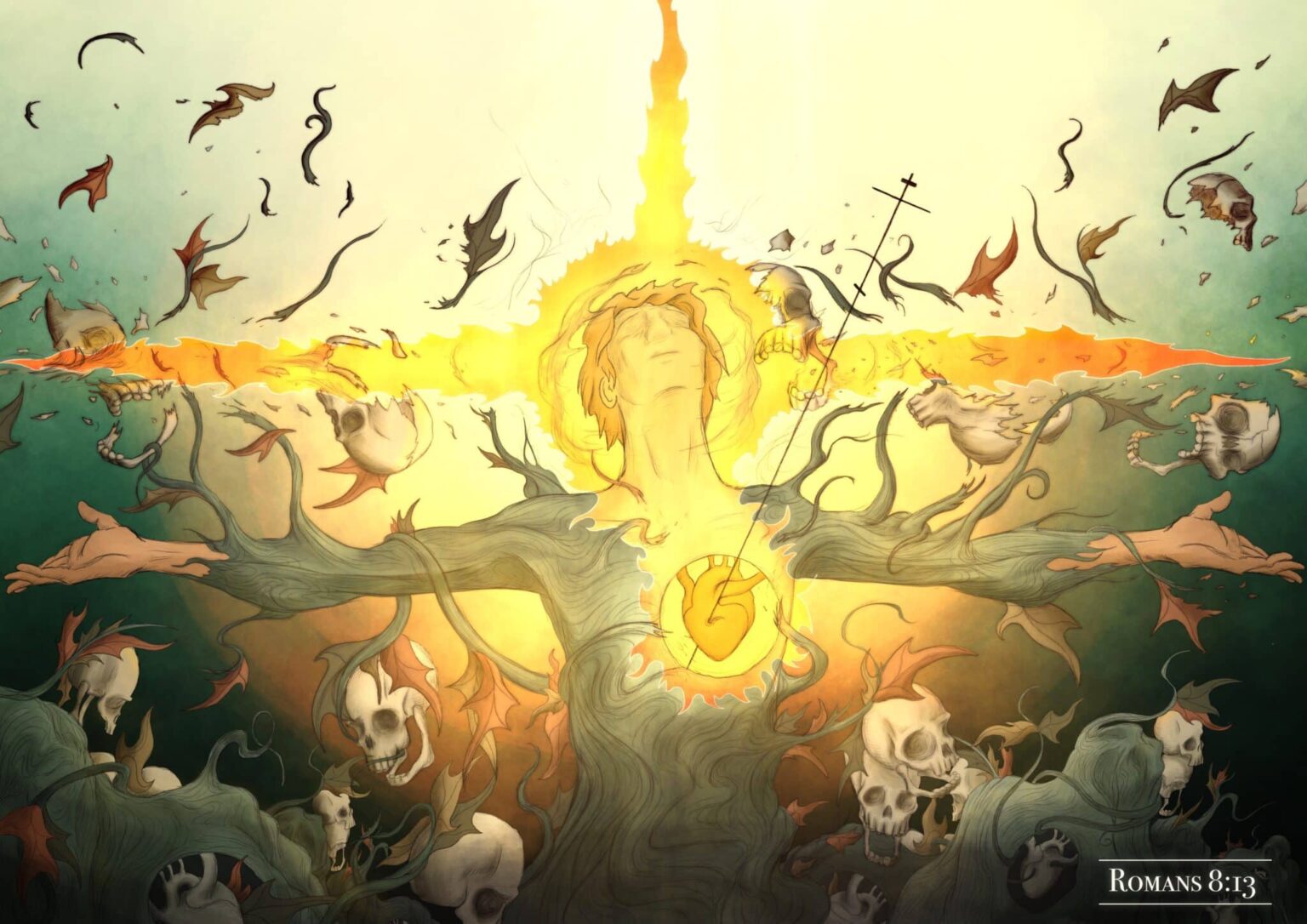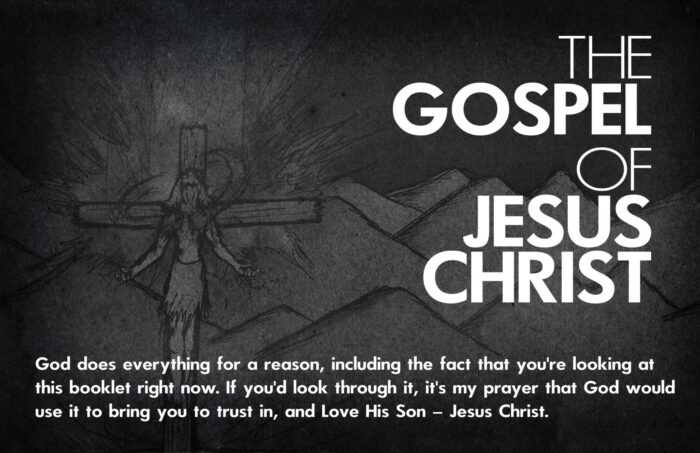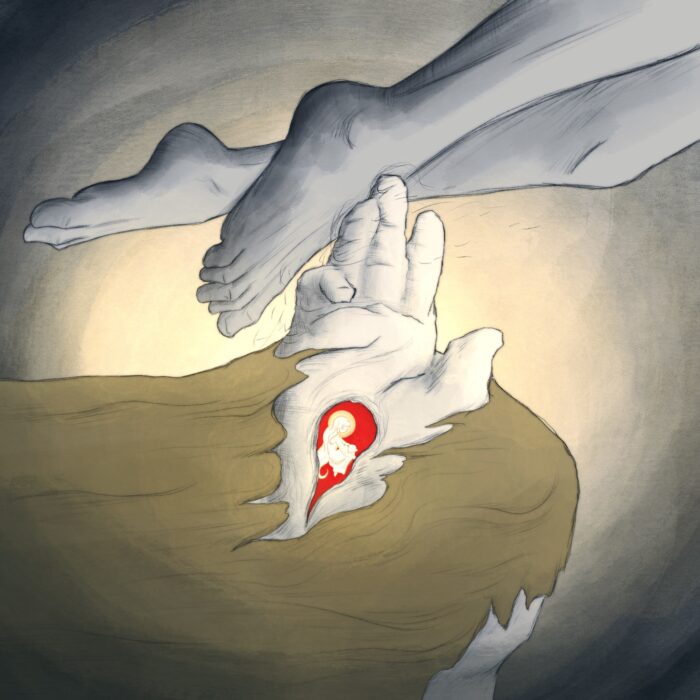
“For if you live according to the flesh, you will die, but if by the Spirit you put to death the deeds of the body, you will live.”
– Romans 8:13
The Passage Explained
In Romans 8:1-4, Paul explains that there is no longer any condemnation for one who is in Christ. This is because God has condemned the sins of His people in the flesh of His Son on the cross so that the requirement of the law (love, Romans 13:9-10) can now be fulfilled in the lives of those walk/live according to the Spirit and not according to the flesh. It would seem, then, that to be “in Christ” is synonymous with—or at least necessarily results in—walking according to the Spirit rather than the flesh. It is only in this (grace-enabled, grace-sustained, Romans 5:8-10) state of “walking in the Spirit” / being “in Christ” that one is able to love as Christ has loved.
Then, in verses 5-11, Paul then explains why the law can only be fulfilled in one who walks according to the Spirit. In the first half of this section (verses 5-8), he shows that to live in accordance with the flesh is ultimately spiritual death because the one who is in the flesh is—by nature—opposed to God and cannot obey His law. To be hostile toward God at the very roots of one’s being is the essence of death—both physical and spiritual. This is the state of all who are “in the flesh.”
However, as Paul goes on to say in verses 9-11, the one who is in Christ is no longer properly considered “in the flesh,” but “in the Spirit.” This is because the Holy Spirit of God—the Spirit who raised Jesus bodily from the dead—now dwells in them as a new nature that dispels and supersedes the old nature of the flesh. Just as having flesh at the roots of one’s nature is spiritual death now and will lead to bodily death later, so too to have the Holy Spirit at the roots of one’s nature is spiritual life now and will lead to resurrected bodily life in eternity.
In verse 12, Paul draws an inference from all that he’s said in verses 5-11 concerning the nature of the one who is in Christ, namely, that—being in Christ—they are no longer enslaved to the flesh and indebted to live according to it. Paul explains this in verse 13 by saying that one who lives according to the flesh will die (that is, be cut of from the presence of God), but that one who puts to death the deeds of the body by the Spirit will live (that is, enjoy the presence of God). The Spirit-filled Christian cannot be a debtor to the flesh because the Spirit will—by His very nature—lead the believer into war against the deeds of the flesh.
This is further explained in verse14, “for, all who are led by the Spirit of God are sons of God.” The logic is that one who puts to death the deeds of the body by the Spirit is—in the act of putting the flesh to death—being led by the Spirit and thus proves themselves to be a son of God. One does not become a son by putting the flesh to death, but proves themselves to be a son in doing so. So, the one who puts to death the flesh by the Spirit in verse 13 does not perish but instead lives, not because they are putting the flesh to death, but because in putting the flesh to death they prove that they are sons….it is their sonship, not their war against the flesh, that preserves their lives. However, if there is no war, they are not sons, and they will perish.
Taken in its context—especially in light of verse 14—verse 13 is not so much a command—though, implicitly, it is certainly that—as it is a statement of fact. It is similar to a doctor who says, “if your heart stops beating, you will die, but if by the strength of your muscles, your heart continues to beat, you will live. For everyone who’s heart is beating is alive.” The Christian’s Spirit-led war against the flesh is not the means to, but the necessary evidence of spiritual life, because it shows that they are being led by the Spirit, and all who are so led are sons of God.
The Picture Explained
In this picture the “deeds of the body” are pictured as sickly, death-bearing tendrils that grow from the unregenerate heart. At the sides of the image and in the background, I pictured “mummified” human forms, those who have given themselves wholly to the flesh and are thus spiritually—and soon to be physically—dead. If the Christian were to cease war against these deeds, they too would perish, and so be proven never to have truly been in Christ.
That being said, my primary desire in planning this picture was to show that the Christian’s war against the “deeds of the body” is not something that secures their status as Spirit-filled children of God, but instead flows necessarily from that regenerate nature. To show this I made the new heart of the believer central to the image. Regeneration is pictured by the heart pierced with the cross of Christ (imaging faith in the crucified and risen Lord) and wreathed in flame (imaging the indwelling Holy Spirit). The fire also engulfs the man’s upturned face and radiates outward into a halo because the Spirit leads us on in sanctification by illuminating our hearts and minds to perceive the glory of God in the face of Jesus Christ (John 16:14-15; 2 Corinthians 3:18, 4:6).
The regenerate status of the man is the visual and conceptual center of this picture. With that established I attempted to show how “putting to death the deeds of the body” is a natural result of being a Spirit-filled, Christ-enamored son of God. To put to death the deeds of the body is just another way to talk about sanctification, and sanctification happens as we are transformed more and more into the image of God as manifest in Jesus Christ, and this transformation happens as we behold more and more the all-satisfying beauty of God in Christ by the Spirit (again, 2 Corinthians 3:18). With this in mind, I pictured the action of “putting to death” the flesh as a side effect of the man’s Spirit-illumined beholding of Christ. As the man perceives more of the excellencies of the crucified and risen Son by the Spirit (represented by his fire-wreathed, upturned face), the effects of that beholding (pictured by the fiery lances shooting from the left and right of his face) tear away the still-clinging fruits of sin.
But sin is not slain merely by a perception of spiritual beauty, we must also be conformed to that spiritual beauty—if we claim to abide in Christ, we must walk as He walked (1 John 2:6). Thus, the man’s arms are pictured outstretched in the form of a crucifix, the self-giving love of the Lord whom he beholds imaged in the actions of his life. Notice that if the man’s arms were not outstretched in imitation of Christ’s love, then the fires of his Spirit-illumened beholding would not shear away the deeds of the flesh. It is the combination of beholding the beauty of God in the crucified Christ and being an image of that beauty in the world, of adoring our risen Lord and acting as He acted, that conspires to slay indwelling sin.
So may we walk by the Spirit (Galatians 5:16 ), perceiving by His ministry the Father-manifesting beauty of the risen Son who was crucified in love for us (John 14:9, 16:14; 2 Corinthians 3:18, 4:6), and beholding may we be transformed into the same image of self-giving, God-exalting love so that the deeds of the flesh are put to death and we are shown to be children of God, to His eternal glory and our eternal joy. In Jesus’ saving name—Amen!




